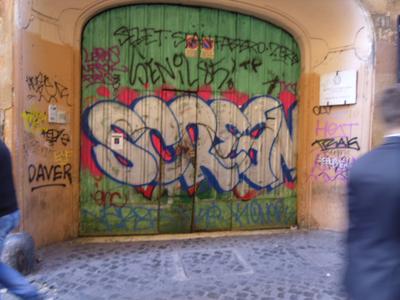Should you always remove graffiti in your neighborhood

Visitor Question: In the past I've always regarded it as a necessity to get rid of graffiti as soon as it happens. I thought it signals a low-quality neighborhood if it is allowed to stay there. Of course, getting rid of it completely is tough to do, but even if you blur it out a bit, it has always seemed better to me.
However, lately some factions of our neighborhood seem to think it would be better to focus on other neighborhood revitalization strategies more than worrying about every single piece of graffiti that appears. One of them said that the "broken windows" theory has been discredited, and now it is time to do whatever it takes to continue to attract young residents who are in work force and make a good salary. What do you think?
Editors Reply: It sounds as if some of your neighbors think graffiti is automatically attractive to young people. There may be a tendency for young people to be more tolerant than their elders would be, but we haven't heard any American young people yet saying oh, we are looking for a neighborhood with graffiti. Instead, they are looking for a walkable neighborhood, where houses have either some "character" or striking modern features, and where there are restaurants, bars, and neighborhood shopping nearby.
As for your core question about whether always removing graffiti is necessary or desirable, we think it depends on your neighborhood and the cultural norms there.
Right off, we can tell you that graffiti does not seem to have the same very negative connotation in European cities as it does in American cities. So part of our answer is that you need to appreciate what your city thinks of graffiti, and if the meaning of it is seen as quite negative, then we advise you to get rid of it as quickly and thoroughly as possible.
Just to put a finer point on it, we uploaded a couple of photos of graffiti in large European cities. One looks much more like it has a real and meaningful message to convey than the other, we think, but would you agree? So with the exception of a few remarkable and serious artists who work in graffiti, even the definition of meaningful graffiti would depend on the interpretation of the residents.
So you are asking the right question, because many Europeans seem to accept that graffiti happens and it does not necessarily mean your neighborhood is on a downhill skid. However, if you are in a U.S. city, most often residents, prospective home buyers, future businesses, and visitors interpret graffiti negatively.
If your graffiti is mean-spirited or demeaning to
any ethnic or other group, you need to not only clean it up within a day or two, but also to make some sort of social media statement about how unacceptable this is.
Calls for violence or gang-related tagging also should be removed as quickly as possible. Gang activity often leads to the appearance of rival gangs, and the last thing you need is two or more gangs battling on your turf.
However, you also need to watch for the response when you successfully remove graffiti. Do these "artists" or vandals, whichever you consider them to be in your city, immediately come back with a bigger and better version of their previous work? If you find that escalation is more likely than discouraging the vandalism, then you will need to rethink how you approach the issue.
You seem to imply that getting the graffiti removed is a big problem. If you have to rely on do-it-yourself types of graffiti removal products bought online or from large janitorial supply stores, it can take a number of applications, elbow grease, and perseverance to make graffiti go away.
Find a city in your region that has a successful graffiti removal program and learn what heavy-duty professional substances they are using. We somewhat disagree with your comment that blurring out the graffiti is better than letting it stand. We think a poor graffiti removal job just sends a message that you aren't up to the task and can't do anything about it if someone does tag you.
Be especially mindful not to harm the surfaces of buildings or any permanent structures. Chemicals that are too harsh might get rid of graffiti, but you don't want to lose the spray paint but also etch the writing into a wall.
Try a few other approaches too. If you catch the artists (or vandals), ask them why they are doing it and whether they might be happy with another place to make the graffiti. Sometimes if you can persuade these people to group their work together, the combined graffiti wall can become a feature rather than a sign of neighborhood decay. If those doing the spray painting are indeed bent on destruction, however, you are best advised to remove the graffiti as soon as possible. Letting it be for six months won't act as a deterrent, so if you want to go the removal route, see that it is handled regularly.
You are doing the right thing by having a robust discussion within the neighborhood because ultimately there is no right or wrong answer; it's all about the meaning you assign to the graffiti.
Join GOOD COMMUNITY PLUS, which provides you monthly with short features or tips about timely topics for neighborhoods, towns and cities, community organizations, and rural or small town environments. Unsubscribe any time. Give it a try.


